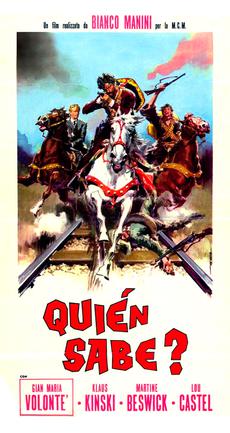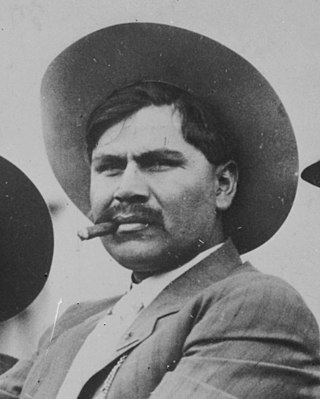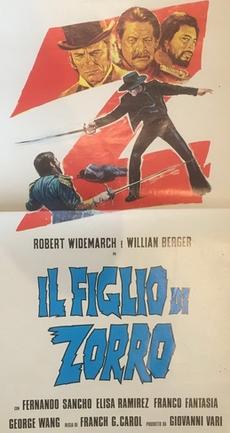
The Satsuma Rebellion, also known as the Seinan War, was a revolt of disaffected samurai against the new imperial government of Japan, nine years into the Meiji era. Its name comes from the Satsuma Domain, which had been influential in the Restoration and became home to unemployed samurai after military reforms rendered their status obsolete. The rebellion lasted from 29 January until 24 September of 1877, when it was decisively crushed, and its leader, Saigō Takamori, was shot and mortally wounded.

Duck, You Sucker!, also known as A Fistful of Dynamite and Once Upon a Time ... the Revolution, is a 1971 epic Zapata Western film directed and co-written by Sergio Leone and starring Rod Steiger, James Coburn, and Romolo Valli.

The Battle of Shiroyama took place on 24 September 1877, in Kagoshima, Japan. It was the final battle of the Satsuma Rebellion, where the heavily outnumbered samurai under Saigō Takamori made their last stand against Imperial Japanese Army troops under the command of General Yamagata Aritomo and Admiral Kawamura Sumiyoshi. The battle culminated in the annihilation of Saigō and his army, marking the end of the Satsuma Rebellion. The Imperial Army's victory consolidated their power, and the Satsuma Rebellion was the last instance of internal mutiny seen in the Empire of Japan.

The Dollars Trilogy, also known as the Man with No Name Trilogy, is an Italian film series consisting of three Spaghetti Western films directed by Sergio Leone. The films are titled A Fistful of Dollars (1964), For a Few Dollars More (1965) and The Good, the Bad and the Ugly (1966). Their English versions were distributed by United Artists, while the Italian ones were distributed by Unidis and PEA.
Five Man Army may refer to:

A Bullet for the General, also known as El Chucho Quién Sabe?, is a 1966 Italian Zapata Western film directed by Damiano Damiani and starring Gian Maria Volonté, Lou Castel, Klaus Kinski and Martine Beswick. It tells the story of El Chuncho, a bandit, and Bill Tate, a counter-revolutionary contract killer in Mexico. Chuncho soon learns that social revolution is more important than mere money.

Compañeros is a 1970 Italian/Spanish/French international co-production Zapata Western buddy comedy film directed by Sergio Corbucci. The film stars Franco Nero, Tomas Milian, Jack Palance and Fernando Rey. The soundtrack for the film was written by Ennio Morricone.
The Gold Medal of Military Valor is an Italian medal established on 21 May 1793 by King Victor Amadeus III of Sardinia for deeds of outstanding gallantry in war by junior officers and soldiers.

In the American Revolution, gaining freedom was the strongest motive for Black enslaved people who joined the Patriot or British armies. It is estimated that 20,000 African Americans joined the British cause, which promised freedom to enslaved people, as Black Loyalists. Around 9,000 African Americans became Black Patriots.

Villa Rides is a 1968 American Technicolor Western war film in Panavision directed by Buzz Kulik and starring Yul Brynner as Mexican revolutionary Pancho Villa and Robert Mitchum as an American adventurer and pilot of fortune. The screenplay is based on the biography by William Douglas Lansford. The supporting cast includes Charles Bronson as Fierro, Herbert Lom as Huerta and Alexander Knox as Madero.

General Rodolfo Fierro was a railway worker, railway superintendent, federal soldier and a major general in the army of Pancho Villa during the Mexican Revolution in the Division del Norte. Fierro and his counterpart and fellow lieutenant, Tomas Urbina, have been cited as the two halves of Pancho Villa, Fierro representing his malicious side. It is believed Fierro met Pancho Villa in 1913 following the Madero revolution. Originating from Sinaloa, Fierro was a former federal officer having taken part in fighting against the Yaqui Indians. Following his role as a federal officer, Fierro went on to work as a railway man, eventually being absorbed into Villa's ranks.

The Hills Run Red is a 1966 spaghetti Western film directed by Carlo Lizzani. The film stars Thomas Hunter in the heroic lead role, along with veteran American actors Henry Silva and Dan Duryea.

The Mexican Border War, or the Border Campaign, was a series of military engagements which took place in the Mexican–American border region of North America during the Mexican Revolution. The period of the war encompassed World War I, and the German Empire attempted to have Mexico attack the United States, as well as engaging in hostilities against American forces there itself.
The Raid onNorias Ranch was an incident in August 1915 in which a large band of Mexican Seditionistas attacked an American ranch in southern Texas. It became one of the many small battles fought on American soil during the Mexican Revolution and resulted in an increased effort by the United States Army to defend the international border. At least seven people were killed in the raid and several more from among those wounded by gunfire may have died immediately afterwards.
The Bandit War, or Bandit Wars, was a series of raids in Texas that started in 1915 and finally culminated in 1919. They were carried out by Mexican rebels from the states of Tamaulipas, Coahuila, and Chihuahua. Prior to 1914, the Carrancistas had been responsible for most attacks along the border, but in January 1915, rebels known as Seditionistas drafted the Plan of San Diego and began launching their own raids. The plan called for a race war to rid the American border states of their Anglo-American population and for the annexation of the border states to Mexico. However, the Seditionistas could never launch a full-scale invasion of the United States and so the faction resorted to conducting small raids into Texas. Much of the fighting involved the Texas Ranger Division, but the US Army also engaged in small unit actions with bands of Seditionist raiders.

Emil Lugwig "Lewis" Holmdahl was an American soldier of fortune, infantryman, machine gunner, spy, gun runner, and treasure hunter who fought under Frederick Funston and John J. Pershing in the Spanish–American War and subsequent Philippine–American War, under Lee Christmas in Central America, under Francisco Madero, Pancho Villa, and Venustiano Carranza in the Mexican Revolution, and under John J. Pershing again in World War I. In 1926, Holmdahl was accused of having stolen Francisco "Pancho" Villa's head.

The Bombing of Naco was an international incident which occurred in the border town of Naco, Arizona, during the 1929 Escobar Rebellion. While rebel forces were battling Mexican 'Federales' for control of the neighboring town of Naco, Sonora, the Irish-American mercenary and pilot Patrick Murphy was hired to bombard the government forces with improvised explosives dropped from his biplane. During the ensuing fighting, Murphy mistakenly dropped bombs on the American side of the international border on three occasions, causing significant damage to both private and government-owned property, as well as slight injuries to several American spectators watching the battle from across the border. The bombing, although unintentional, is noted for being the first aerial bombardment of the continental United States by a foreign power in history.

Man with the Golden Winchester is a 1973 Spaghetti Western-adventure film directed by Gianfranco Baldanello and starring Alberto Dell'Acqua and Fernando Sancho.

The Cuban Revolution of 1933, also called the Sergeants' Revolt, was a coup d'etat that occurred in Cuba in September 1933. It began as a revolt of sergeants and enlisted men in the military, who soon allied with student activists in the Directorio Estudiantil Universitario.
Myōrin (妙林) or YoshiokaMyorin-ni (吉岡妙林尼) was a late-Sengoku period female warlord onna-musha. She was the wife of Yoshioka Akioki a samurai warlord, and served Otomo clan in Bungo. She was the heroic woman who defended the Otomo clan in the Kyūshū campaign against Shimazu's army. Her contributions to the Kyushu campaign were so significant that they completely changed the course of history and she was highly praised by Japan's most powerful man at the time, Toyotomi Hideyoshi. Later, she was named Guardian of Tsurusaki, an honorary title due to her heroic acts.














